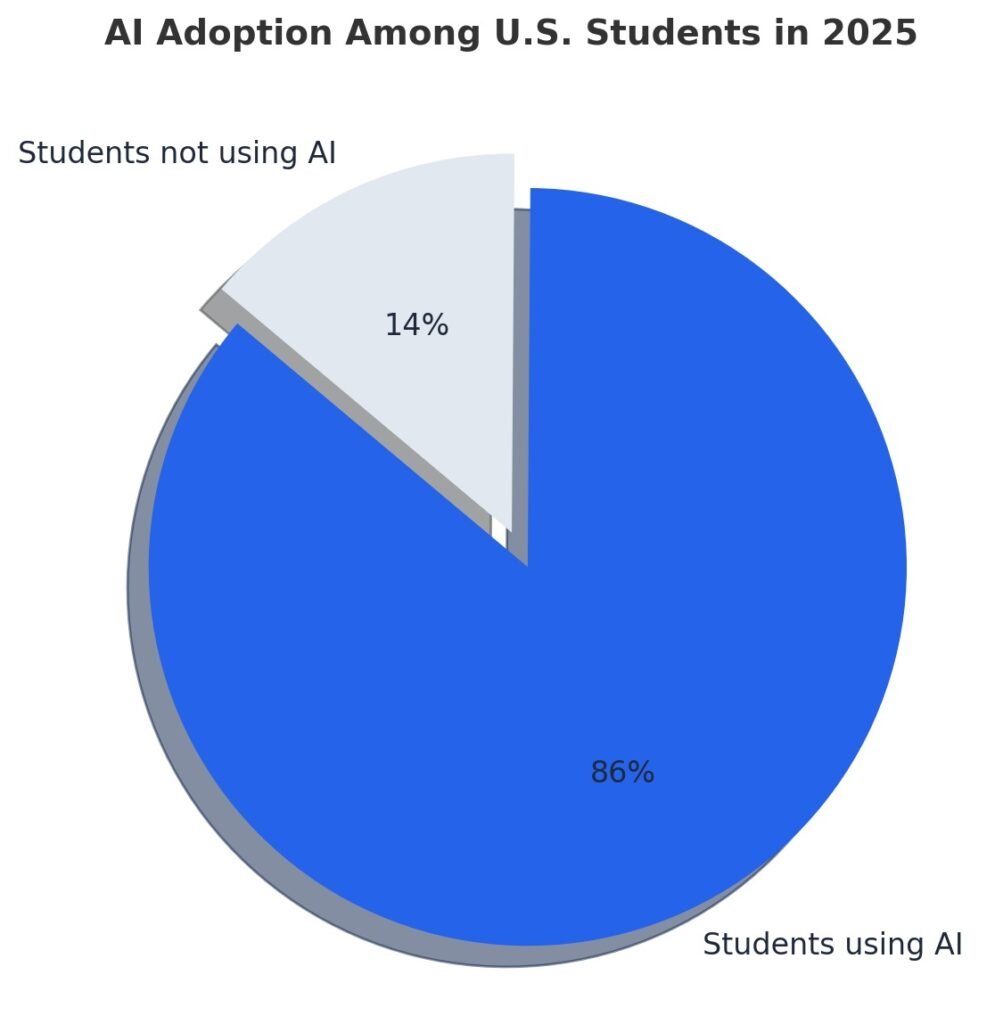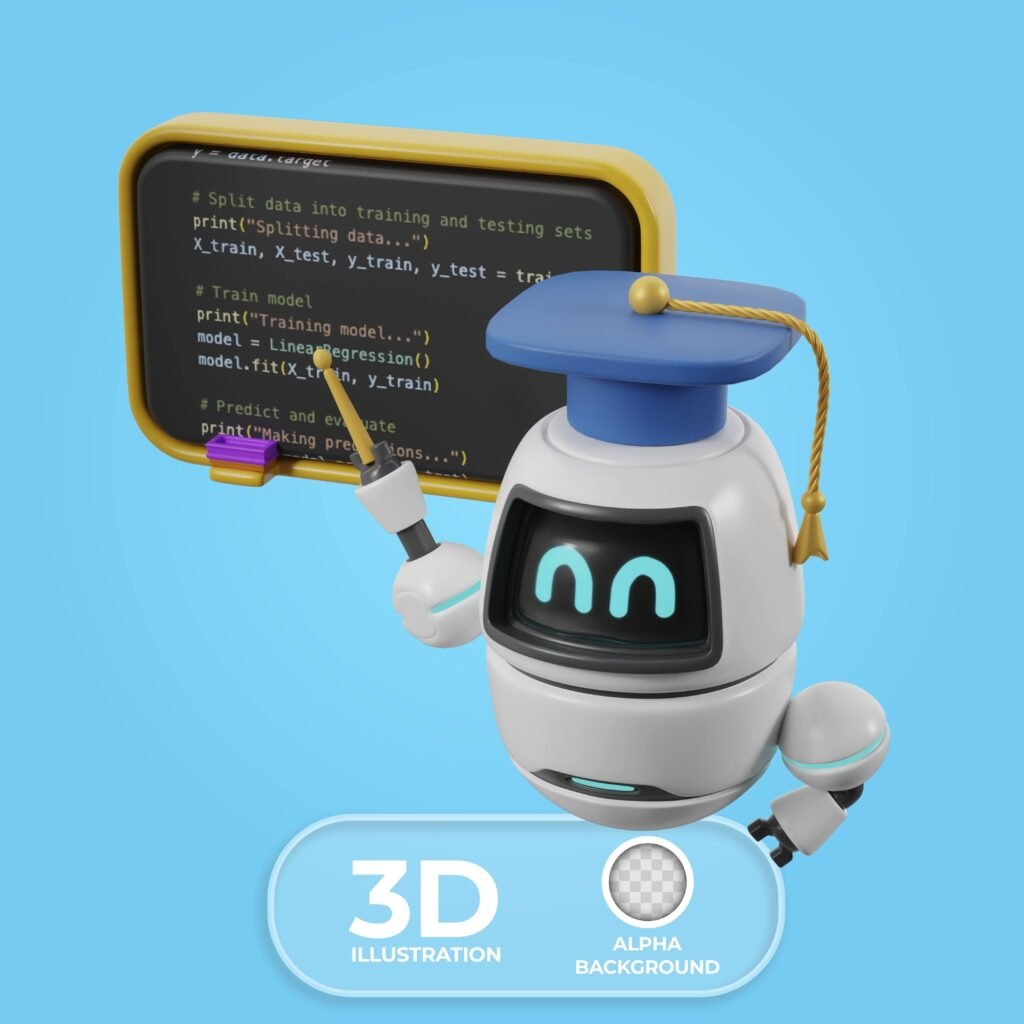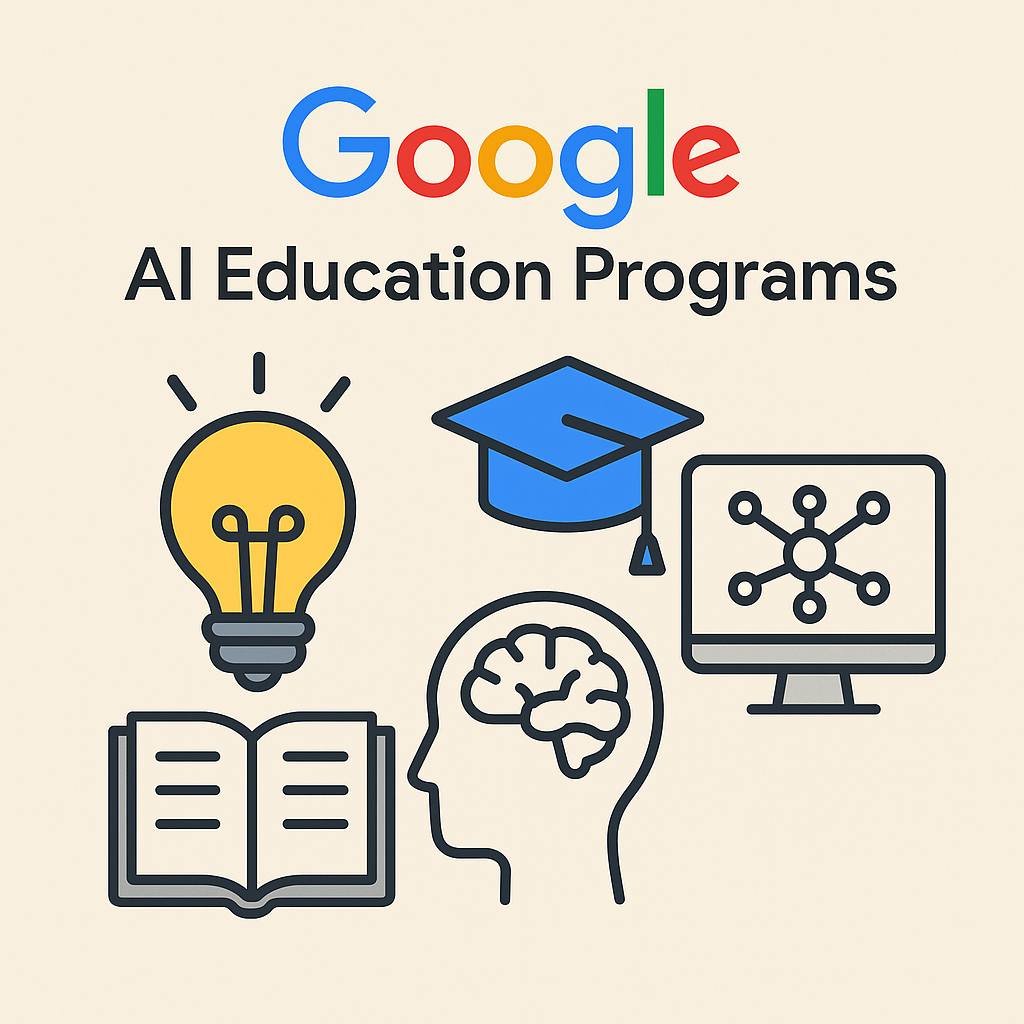The Rise of AI in Education
By 2025, artificial intelligence will be widely integrated into American classrooms. About 86% of college students now use AI in their studies, according to surveys. These tools, like chatbots that explain things and apps that make study guides for you, promise faster learning and help that is tailored to your needs.
The best AI tools for students in the USA 2025 are discussed in this article, along with an analysis of how each one improves academic performance. We will use the most recent data and expert opinions to help students choose the right tools while still keeping their academic integrity.
AI-powered tools have gone from being interesting to being a must-have in the classroom. Sundar Pichai, the CEO of Google, says that “bringing powerful AI to students has always been core to Google’s mission.” Big tech companies and teachers both see a lot of potential in things like free Chromebooks and AI-powered tutoring.
A survey by the Digital Education Council found that ChatGPT had already helped 66% of students with writing and homework. Grammarly and Microsoft Copilot had each helped about 25% of students. These numbers highlight a new reality: learning how to use the best AI tools for students in the USA 2025 is becoming necessary for academic success.
When you finish this guide, you will have a clear picture of the best AI-powered apps and platforms. We’ll talk about different types of study aids, writing aids, productivity apps, and more, and we’ll use data and examples to show what we mean. We’ll also talk about issues like cheating and bias to make sure students know how to use AI responsibly.
This article is a practical Forbes-style guide to using AI in education today. It has short sections, quotes from experts, and bullet points.

Current Trends: Using AI in Education
By 2025, AI will be everywhere in education. A Cengage Group report says that 86% of college students in the U.S. use AI in their classes, and more than half (54%) say they use AI every week. Even in K–12, the number of people who used it went from 37% to 75% every year. Almost half of college instructors (45%) and more than half of K–12 teachers (51%) say they use AI tools in their classes. These numbers show a bigger change: almost everyone involved thinks that AI will play a bigger role in learning.
Students say they use AI for a lot of things. A worldwide survey found that the most common uses were looking up information (69% of students), checking grammar (42%), summarizing documents (33%), paraphrasing (28%), and writing essays (24%). That means a lot of people use tools like Grammarly (for editing) or ChatGPT and Bard (for Q&A and writing help). According to a report from Campus Technology, students use an average of 2.1 AI tools per course, with ChatGPT being the most popular (66%).
Teachers are cautiously hopeful. A survey by the Consortium for School Networking found that 97% of district leaders think AI could be helpful in schools. But only about a third (35%) have started AI projects. This “wait-and-see” attitude shows worry about misuse and a lack of training. A Microsoft study found that 22% of teachers use AI every day, but only 24% feel confident using it.
States and institutions are moving quickly to fill the gap. California now requires K–12 students to learn about AI, and UNESCO has made a list of AI skills that teachers should have. Indiana University even has a free “GenAI 101” course to get students and teachers ready for AI-based learning.
These trends lead us to our main topic, which is finding the best AI tools for students in the USA 2025. To help students study smarter, we’ll look at the best apps and platforms in the next few sections, organized by what they do.
Best AI Tools That Are Changing How Students Learn
Chatbots and virtual tutors that use AI
AI chatbots today are like personal study buddies. ChatGPT (OpenAI) is a great example. Its new Study Mode makes the chatbot a teacher. Students can make flashcards, quizzes, and explanations that are just right for them by typing “/study” and picking a subject. This makes review sessions very interactive.
Study Mode is like having a low-pressure personal tutor that “reinforces what you’re learning in class,” according to one tech editor. Google’s Gemini (also known as Bard) has similar features, such as a new Guided Learning mode that asks questions step by step instead of just giving answers. These chatbot tutors can help you understand hard math problems, make arguments for essays, or make study guides—all through talking.
Khanmigo, Khan Academy’s AI tutor, is another rising star. Khanmigo was made to help with math and writing, and it is already being tested in 266 school districts in the U.S. Like a patient teacher, students ask Khanmigo questions and Khanmigo gives them hints and feedback instead of straight answers.
Even though it’s still in the testing phase, its quick adoption shows that the best AI tools for students often combine human-like help with instant access.
Claude from Anthropic and search-based assistants like Perplexity AI are two other AI chatbots that are worth mentioning. We only talk about big names here, but the field is growing every day. AI assistants are great at explaining things, testing the student, or giving examples, which is very useful for studying for tests or coming up with ideas for homework.

Help with Writing and Research
Students often have to write papers and reports, but AI tools have made that easier. Grammarly has been a favorite for a long time, but by 2025, it’s much more than just a spell checker. Its AI can now help students improve their writing by giving them suggestions based on the context, changing the tone, and rewriting sentences to make them clearer. For instance, Grammarly can point out a sentence that doesn’t make sense and explain why it’s unclear or give feedback in an academic style.
It even has a built-in plagiarism checker that lets writers make sure they are citing their sources correctly. The end result is that Grammarly improves the final draft so that it “lands the way you want it to.
Google NotebookLM is now a great tool for research. Students can upload their slides, PDFs, or class notes to NotebookLM and then ask questions about them. It can make a study guide from documents you upload, summarize long readings, or highlight key points. You could think of it as a search engine and a tutor for your own course materials.
In real life, a history student might upload notes from a Civil War lecture and ask NotebookLM to explain the causes, which would save them hours of reading through the notes by hand.
These tools make it easier to write. Because of this, a lot of students now use them to write and edit. A worldwide survey found that 24% of students used AI to write a first draft and 28% to rewrite text.
The best AI tools for students in the USA 2025, in a nutshell, are those that work with the student when conducting research or writing: Grammarly and NotebookLM are the most popular, but there are also a lot of other options, such as Microsoft Copilot for Office (which comes with Word and Outlook) and Elicit (for reviewing academic literature).
Tools for productivity and working together
AI can help with more than just writing and tutoring. Otter.ai is an example of an AI-driven transcription service. Otter will make a time-stamped transcript with highlights of important parts of lectures or study group sessions that students record. Later, they can look through their recordings by keyword or send a summary to their notes.
This is a game-changer for people who learn by listening because it makes sure that no details are lost when a professor talks quickly. The developer says that Otter is “especially helpful for students with learning differences” or anyone who has to keep track of more than one class.
Apps for taking notes have also gotten smarter with AI. Notion AI and Evernote, for example, now have tools that can summarize meeting notes or make outlines from bullet points. Google Workspace tools like Docs, Slides, and Sheets also use AI to help with writing and design.
Think about how AI could help you write a better introduction to an essay in Google Docs or give you design ideas for Slides. These integrations save time because students don’t have to switch between apps; they can get help with the ones they already use.
AI features have also been added to collaboration tools like Microsoft Teams and Slack. AI can automatically write up meeting notes, translate chat messages, or suggest tasks. For instance, a group working on a project could use AI to give people jobs based on their skills or to make sure that everyone’s notes cover all the topics. These tools aren’t just for school, but they’ve become a part of the toolkit for students in college and even some high schools.
To put it simply, productivity AI tools do the work behind the scenes. They allow students to focus on their academics. The best AI tools for students in the USA 2025 include collaborative suites with AI, smart note-taking (Notion AI), automatic transcription (Otter.ai), and scheduling/planners. Each of them transforms hours of tedious work into concentrated study sessions, saving a significant amount of time.
Tools for Creativity and Multimedia
AI can also help with creativity, not just learning from text. Canva Pro is a graphic design platform that now has a lot of AI features. With DeepMind’s Veo 3 built in, students can easily make their own infographics, videos, and presentations. For example, do you need a chart for a class project? Canva will make polished images for you if you just tell it what the data and style are.
Veo 3 can also turn text or still images into short videos with sound. This method gives students more power when working on group projects or giving presentations. Instead of having to figure out how to use design software, they just say what they want and let AI make the visuals.
Adobe’s Firefly (for making images) and a number of AI-based video editors are other creative AI tools. A lot of these will be free or have versions for students by 2025. For instance, a student of psychology could ask an AI to make pictures for a poster, or a student of music theory could use an AI composer to try out different melodies. Even coding projects have helpers. For example, Google’s Jules AI (part of the Google AI Pro plan) can write or debug code snippets, which is helpful for computer science classes.
These creative tools are great for people who learn best by seeing or doing things. They let students share their thoughts through the media without having to do much work. In short, the best AI tools for students in the USA 2025 are those that let them design with AI, edit videos with video editors, or even use VR/AR labs. They make creative projects easier by letting you talk to an intelligent assistant instead of having to deal with technology.
| AI Tool | Main Feature | Best For | Usage % (2025) |
|---|---|---|---|
| ChatGPT (Study Mode) | Flashcards, Q&A, Essay Help | College & Uni Students | 66% |
| Google Gemini | Guided Learning, Multimodal | Research & Problem Solving | 42% |
| Grammarly | Grammar, Plagiarism, Tone | Writing & Editing | 25% |
| Khanmigo | Step-by-step Tutoring | K–12 Students | Growing Fast |
| NotebookLM | Summarize PDFs, Notes Q&A | Research & Study Guides | 30% |
| Otter.ai | Lecture Transcription | Note Taking & Productivity | 22% |
Use cases and adoption of AI (2024–25)
- AI is used in academics by 86% of college students.
- Top resources: Microsoft Copilot (25%), Grammarly (25%), and ChatGPT (66%).
- Searching (69%), summarizing (33%), and drafting (24%) are typical tasks.
- About 54% of students use AI every week.
- 83% of students and 92% of faculty believe AI literacy is crucial for classes
(Sources: Digital Education Council 2024 Survey, Cengage 2024 Report).
Examples and Case Studies
The Google AI for Education Accelerator. Google said in August 2025 that it would give U.S. college students free access to advanced AI tools as part of a big project. Any student who is 18 or older can now get a free 12-month “Google AI Pro” subscription. This includes access to Gemini 2.5 Pro (which has open-text and image-based questions), NotebookLM (which has better media support), and 2 TB of cloud storage.
Related: smart saving guide
This means that students at hundreds of colleges can use tools like Gemini and NotebookLM for free. Google is also putting $1 billion into AI education in the US, including free training through its AI for Education Accelerator. In short, big tech companies are betting a lot that every student will use AI tools by 2025.
University Programs: Universities are also using AI, not just tech companies. GenAI 101 at Indiana University is a free online course for students and staff to learn how to use generative AI. People think that AI literacy is a valuable skill for jobs, which is why there are courses like this one that often give out certificates. One teacher said that their goal was to give participants “practical takeaways” so they could “engage in an AI-influenced world.” These efforts show that schools know AI tools are going to be around, so instead of banning them, they’re teaching how to use them responsibly.

The student experience every day: Take a look at this common example: Sarah is a journalism major and uses ChatGPT Study Mode to test her knowledge of history facts (flashcards) and improve her writing. She uses Otter.ai to write down lectures and then uploads the notes to NotebookLM to get a quick summary before finals. Jamal, her classmate, is using Canva + Veo 3 to make a video project for media class and Grammarly to improve his term paper. These stories are similar to survey results: students say they use AI because “it saves time and makes their work better.” The best AI tools for students in the USA 2025 are frequently deemed to be those that are this helpful.
It’s clear from these examples that AI tools are becoming more and more a part of students’ lives. AI education is being added to college courses, and businesses are literally putting advanced AI in the hands of every student. According to experts at Cengage Group, this is only the beginning of what AI can do to make learning more personal.

Advantages of AI in Student Learning
AI tools give you real benefits. Students often say that AI makes work faster and better. For example, a student can make flashcards automatically in seconds instead of spending hours making them by hand. A writing assistant checks an essay for grammar mistakes right away, instead of you having to do it yourself. These improvements in efficiency let students focus on learning instead of just busywork.
AI also makes learning more personal. Tools change to fit each student’s speed: are you having trouble with calculus? An AI tutor can give you more practice until you understand the ideas. Are you good at French? The AI challenge gets bigger. This kind of personalized learning used to only be possible with one-on-one tutoring, but now it works for all students who have an internet connection. Over 80% of the students who took the survey said that being good at AI skills is important for their future jobs. This shows that they value this kind of adaptive learning.
AI also helps people study better. It gets students involved in active learning by asking them questions like “What part of this problem do I not understand?” and giving them quizzes. The goal is to learn everything, not to take shortcuts. AI can be a “supportive study partner,” not just a way to get things done faster, as one education lead said. When used properly Students can go through several drafts and solutions with AI feedback, which improves their communication and critical thinking skills.
Finally, AI aligns with future job requirements. More and more, employers want new graduates to know how to use AI tools. So, knowing how to use ChatGPT or an AI design app doesn’t just help a student today; it also gives them a skill for the future. Colleges know this: 92% of teachers and 83% of students say that teaching AI literacy is important because most students think that AI skills will be useful in their jobs. In short, learning how to use the best AI tools now will help students do well in school and at work.
Problems and ethical difficulties
There are some things to keep in mind about AI’s benefits. A big worry is academic honesty. Some teachers are worried that students will use AI to do their homework for them. Most students use AI to study, not to cheat. A survey in the UK, for instance, found that only 18% of students said they had copied AI-generated text into their homework. Still, a lot of people are worried about AI giving them false or biased information (“hallucinations”). Students need to check facts because an AI tutor might seem sure of themselves but be wrong.
There are also problems with fairness and accessibility. Early data suggest that schools with more money are more likely to use AI than schools with less money, which could make learning gaps bigger. You need to have access to the internet and the right devices to use these tools. The digital divide is still a big problem, though. Amazon’s $100 million AWS Education Equity Initiative and Google’s AI grants are two examples of efforts to fix it.
Another thing to worry about is privacy. When K–12 teachers use AI tools some of them are worried about student data. A recent poll found that about 88% of school leaders think GenAI is a moderate to high risk. Because of this fear districts have made their rules stricter. College students should not give chatbots personal or sensitive information when they use AI. They should also use school-approved platforms whenever they can.
Last but not least, it’s very important to learn how to use AI in a safe way. A lot of teachers talk about how important it is to be honest and open. Always check your school’s rules about using AI. Most people say that AI should be used as a teacher, not as a ghostwriter. Almost all experts now say that instead of banning AI completely, students should be taught how to use it wisely. This means learning how to ask questions that get good answers, how to think critically about what AI gives you, and how to properly cite any work that AI helped you with.
In short, the best AI tools for students are those that help them learn while still following the rules of the classroom. AI can help you instead of being a way to get ahead in school if you use it carefully.
What to expect in the future: 2025 and beyond
AI in education will only get deeper in the future. New models, like GPT-4o and the upcoming GPT-5 series, promise to help us understand hard questions even better. Most likely, AI assistants will be built into all learning platforms. Think about virtual labs where an AI helps you with your science experiments or language apps that talk to you in real time. ChatGPT Edu, an OpenAI project, is already looking into using tools like this on all campuses.
Experts say that AI will also take over more tasks that teachers do. AI could grade multiple-choice tests and make quizzes that are unique to each student, giving teachers more time to mentor. This change is already happening: 42% of teachers who were surveyed said that AI has helped them spend less time on administrative tasks.
But policymakers will have a big part to play. There may be more standard rules for AI in schools by 2025. The U.S. Department of Education and state organizations, such as the Education Commission of the States, are putting together toolkits for using AI safely. These will help students and teachers understand what it means to use AI responsibly.
Michael Hansen, our CEO, said it best: AI has problems, but it also has a lot of potential to make the current education system better.
The next few years will teach us how to keep our integrity while being creative. Smart students and teachers are treating AI as a part of learning that is always changing. If used correctly it can give a new generation of thinkers and creators more power.
Frequently Asked Questions about AI study tools

